Abstract
This review examines the potential of active daily living as a means of gaining the cardiovascular and health rewards previously sought through vigorous aerobic fitness programmes. Cross-sectional studies of occupational and leisure activity show encouraging associations between such activity and good health; in workers, the gross intensity of effort needed for health benefits has seemed to be 20 kJ/min. There has been less unanimity on the threshold intensity needed in leisure activities, but various recent "position statements" have decreased the recommendation to 50% of an individual's maximal oxygen intake, sustained for one hour three to five times per week. Life-style activities such as walking seem likely to reach this intensity in older individuals, but are unlikely to do so in young adults. A growing number of controlled longitudinal studies of walking programmes have demonstrated gains in aerobic fitness, modest reductions in blood pressure, improvements in lipid profile, increased bone density, and enhanced mood state, with less consistent reductions of body fat. However, gains have been greatest in the elderly, sedentary, and obese populations. The main component of active living, fast walking, seems likely to enhance health in such populations, but it is unlikely to be effective in young adults who are in good initial health.
Full text
PDF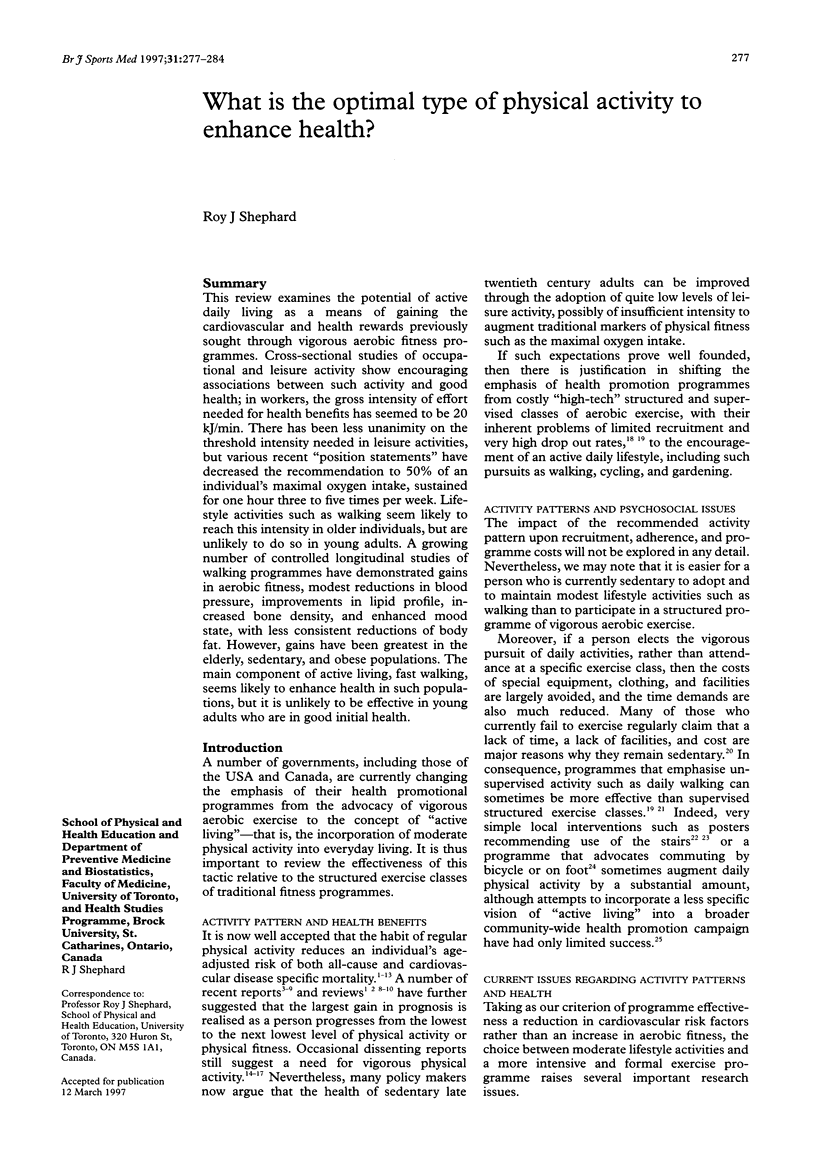
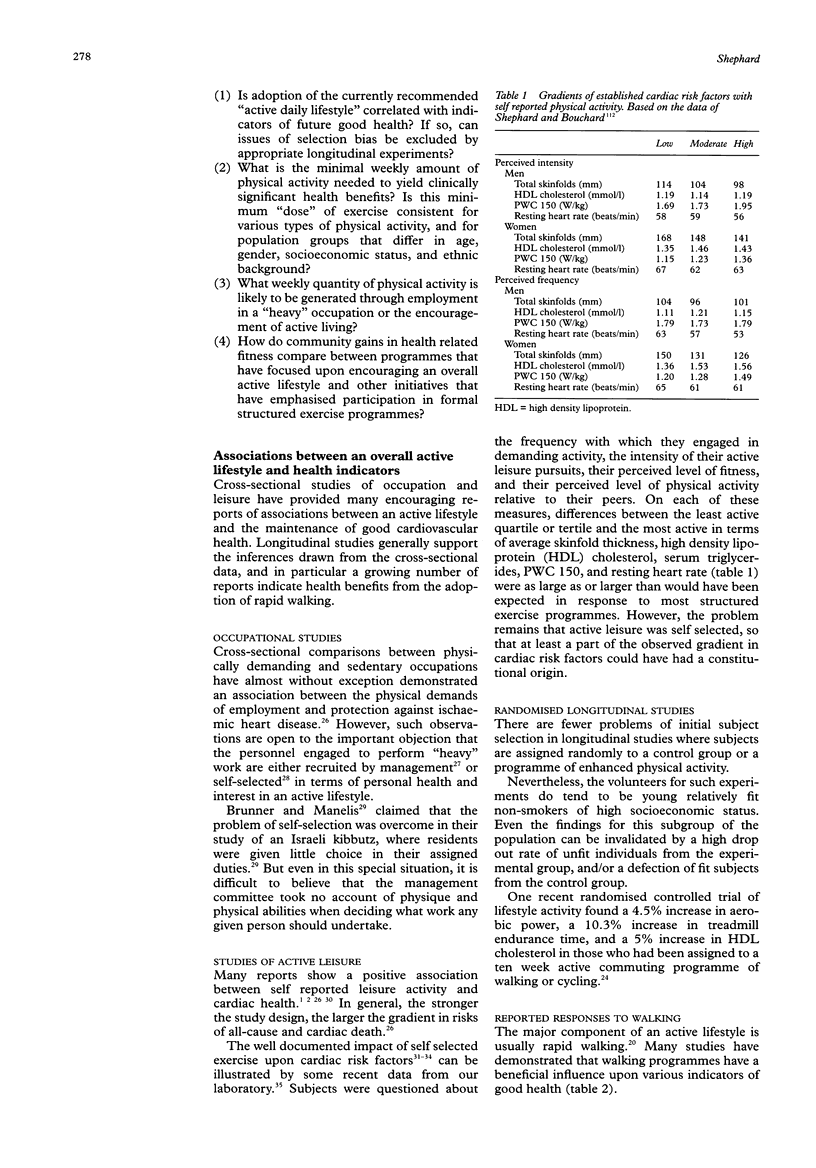
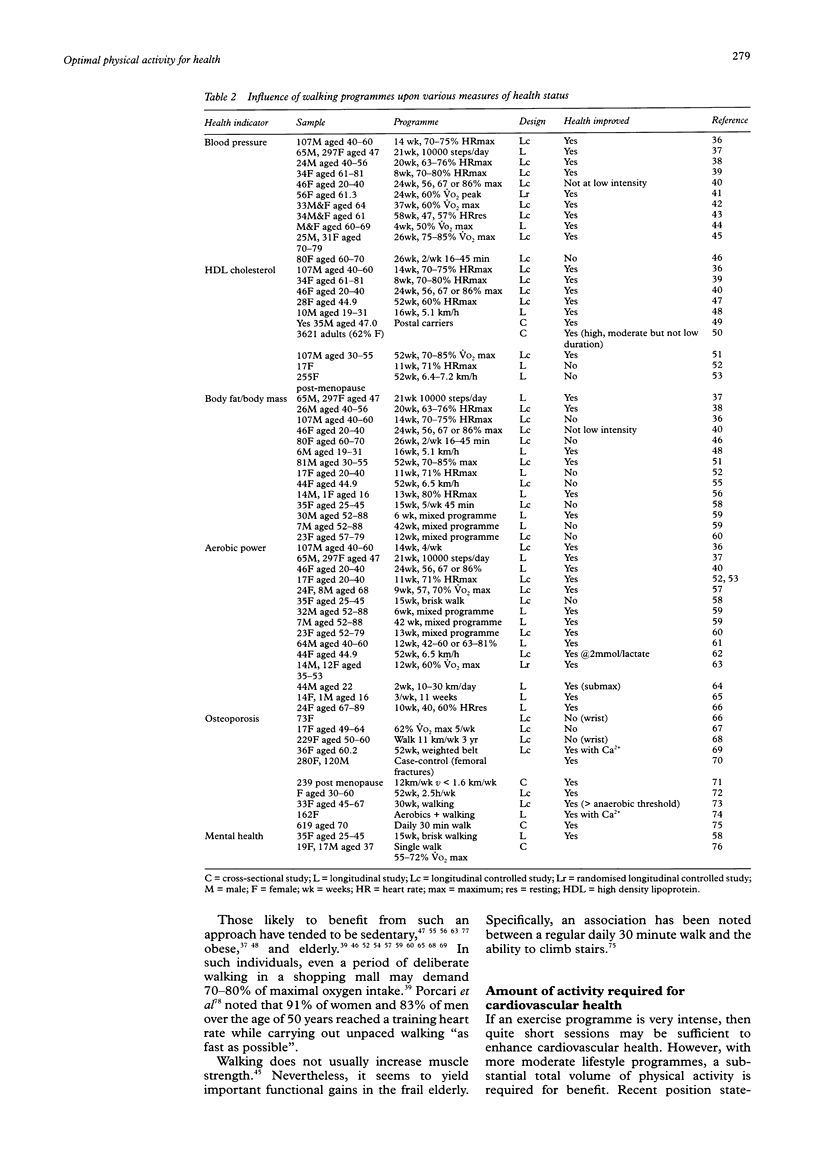
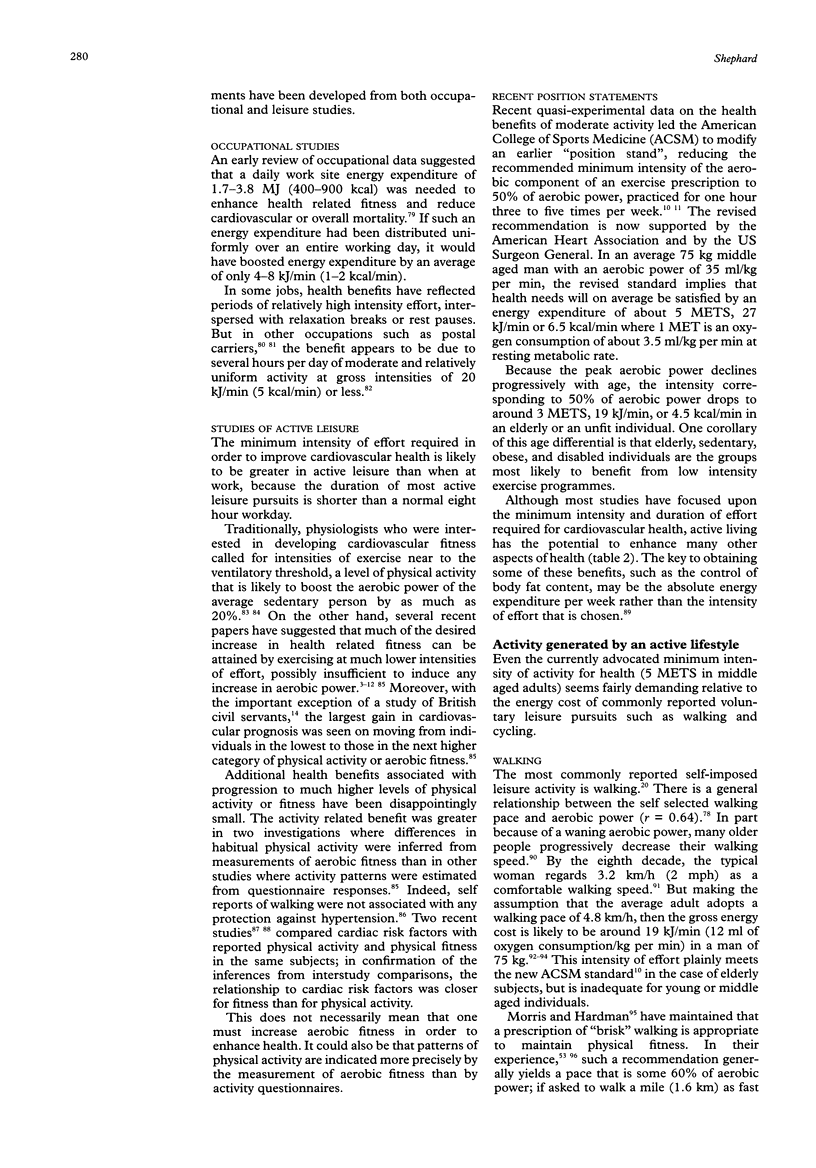
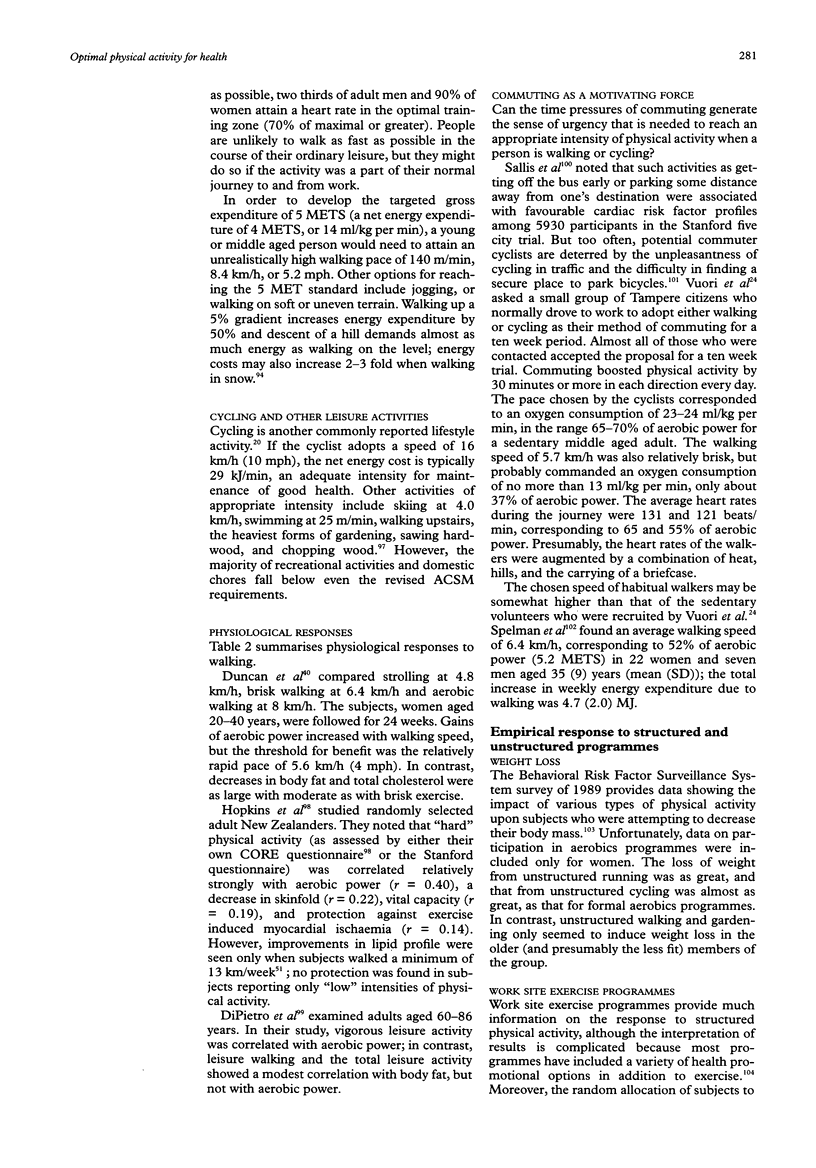
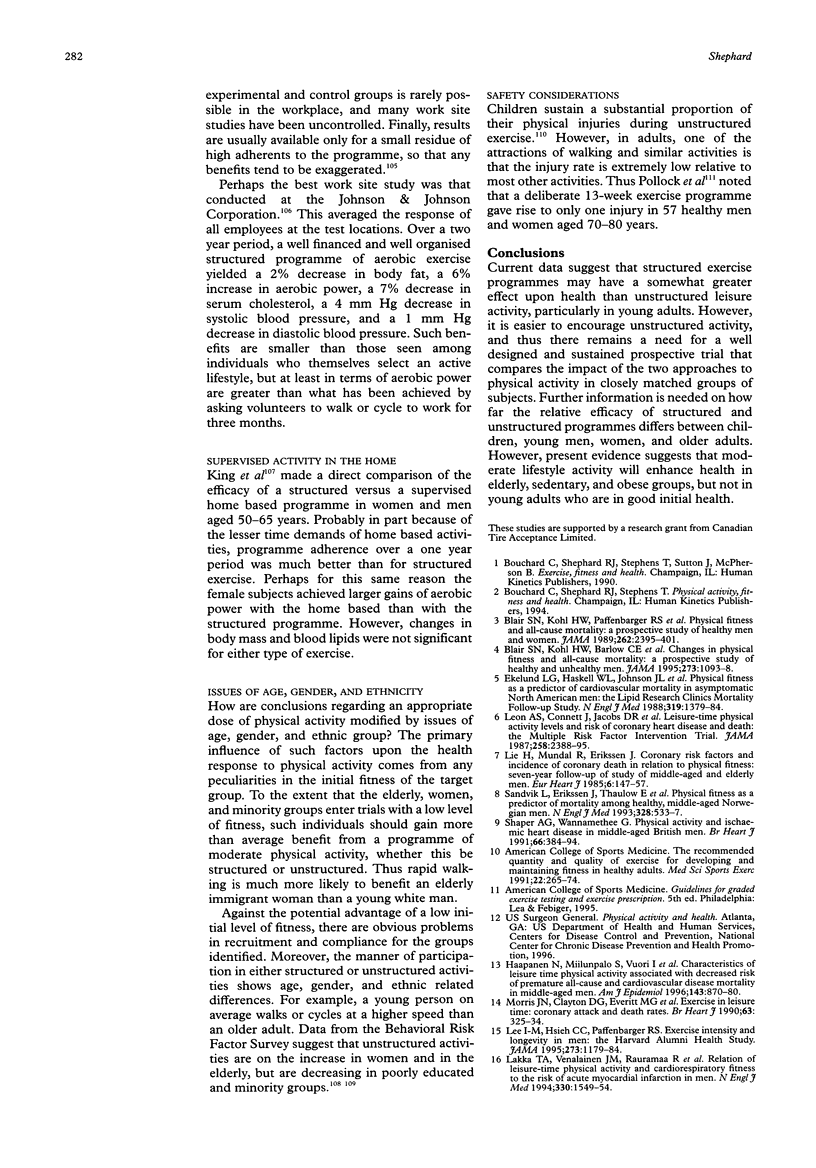

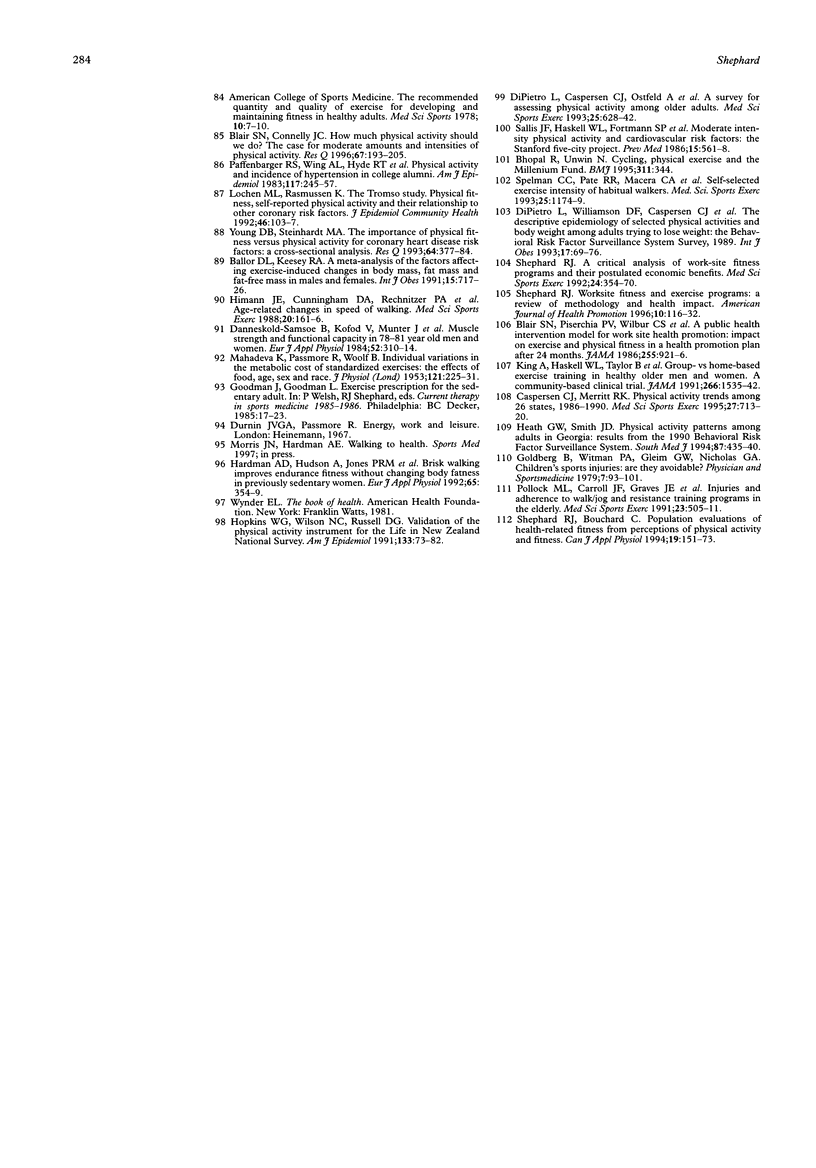
Selected References
These references are in PubMed. This may not be the complete list of references from this article.
- Badenhop D. T., Cleary P. A., Schaal S. F., Fox E. L., Bartels R. L. Physiological adjustments to higher- or lower-intensity exercise in elders. Med Sci Sports Exerc. 1983;15(6):496–502. [PubMed] [Google Scholar]
- Ballor D. L., Keesey R. E. A meta-analysis of the factors affecting exercise-induced changes in body mass, fat mass and fat-free mass in males and females. Int J Obes. 1991 Nov;15(11):717–726. [PubMed] [Google Scholar]
- Berlin J. A., Colditz G. A. A meta-analysis of physical activity in the prevention of coronary heart disease. Am J Epidemiol. 1990 Oct;132(4):612–628. doi: 10.1093/oxfordjournals.aje.a115704. [DOI] [PubMed] [Google Scholar]
- Bhopal R., Unwin N. Cycling, physical exercise, and the millennium fund. BMJ. 1995 Aug 5;311(7001):344–344. doi: 10.1136/bmj.311.7001.344. [DOI] [PMC free article] [PubMed] [Google Scholar]
- Blair S. N., Connelly J. C. How much physical activity should we do? The case for moderate amounts and intensities of physical activity. Res Q Exerc Sport. 1996 Jun;67(2):193–205. doi: 10.1080/02701367.1996.10607943. [DOI] [PubMed] [Google Scholar]
- Blair S. N., Kohl H. W., 3rd, Barlow C. E., Paffenbarger R. S., Jr, Gibbons L. W., Macera C. A. Changes in physical fitness and all-cause mortality. A prospective study of healthy and unhealthy men. JAMA. 1995 Apr 12;273(14):1093–1098. [PubMed] [Google Scholar]
- Blair S. N., Kohl H. W., 3rd, Paffenbarger R. S., Jr, Clark D. G., Cooper K. H., Gibbons L. W. Physical fitness and all-cause mortality. A prospective study of healthy men and women. JAMA. 1989 Nov 3;262(17):2395–2401. doi: 10.1001/jama.262.17.2395. [DOI] [PubMed] [Google Scholar]
- Blair S. N., Piserchia P. V., Wilbur C. S., Crowder J. H. A public health intervention model for work-site health promotion. Impact on exercise and physical fitness in a health promotion plan after 24 months. JAMA. 1986 Feb 21;255(7):921–926. [PubMed] [Google Scholar]
- Blamey A., Mutrie N., Aitchison T. Health promotion by encouraged use of stairs. BMJ. 1995 Jul 29;311(7000):289–290. doi: 10.1136/bmj.311.7000.289. [DOI] [PMC free article] [PubMed] [Google Scholar]
- Brownell K. D., Stunkard A. J., Albaum J. M. Evaluation and modification of exercise patterns in the natural environment. Am J Psychiatry. 1980 Dec;137(12):1540–1545. doi: 10.1176/ajp.137.12.1540. [DOI] [PubMed] [Google Scholar]
- Caspersen C. J., Merritt R. K. Physical activity trends among 26 states, 1986-1990. Med Sci Sports Exerc. 1995 May;27(5):713–720. [PubMed] [Google Scholar]
- Cavanaugh D. J., Cann C. E. Brisk walking does not stop bone loss in postmenopausal women. Bone. 1988;9(4):201–204. doi: 10.1016/8756-3282(88)90031-2. [DOI] [PubMed] [Google Scholar]
- Cononie C. C., Graves J. E., Pollock M. L., Phillips M. I., Sumners C., Hagberg J. M. Effect of exercise training on blood pressure in 70- to 79-yr-old men and women. Med Sci Sports Exerc. 1991 Apr;23(4):505–511. [PubMed] [Google Scholar]
- Cooper K. H., Pollock M. L., Martin R. P., White S. R., Linnerud A. C., Jackson A. Physical fitness levels vs selected coronary risk factors. A cross-sectional study. JAMA. 1976 Jul 12;236(2):166–169. [PubMed] [Google Scholar]
- Cramer S. R., Nieman D. C., Lee J. W. The effects of moderate exercise training on psychological well-being and mood state in women. J Psychosom Res. 1991;35(4-5):437–449. doi: 10.1016/0022-3999(91)90039-q. [DOI] [PubMed] [Google Scholar]
- Danneskiold-Samsøe B., Kofod V., Munter J., Grimby G., Schnohr P., Jensen G. Muscle strength and functional capacity in 78-81-year-old men and women. Eur J Appl Physiol Occup Physiol. 1984;52(3):310–314. doi: 10.1007/BF01015216. [DOI] [PubMed] [Google Scholar]
- De Vries H. A. Physiological effects of an exercise training regimen upon men aged 52 to 88. J Gerontol. 1970 Oct;25(4):325–336. doi: 10.1093/geronj/25.4.325. [DOI] [PubMed] [Google Scholar]
- DiPietro L., Williamson D. F., Caspersen C. J., Eaker E. The descriptive epidemiology of selected physical activities and body weight among adults trying to lose weight: the Behavioral Risk Factor Surveillance System survey, 1989. Int J Obes Relat Metab Disord. 1993 Feb;17(2):69–76. [PubMed] [Google Scholar]
- Dipietro L., Caspersen C. J., Ostfeld A. M., Nadel E. R. A survey for assessing physical activity among older adults. Med Sci Sports Exerc. 1993 May;25(5):628–642. [PubMed] [Google Scholar]
- Dishman R. K., Buckworth J. Increasing physical activity: a quantitative synthesis. Med Sci Sports Exerc. 1996 Jun;28(6):706–719. doi: 10.1097/00005768-199606000-00010. [DOI] [PubMed] [Google Scholar]
- Duncan J. J., Gordon N. F., Scott C. B. Women walking for health and fitness. How much is enough? JAMA. 1991 Dec 18;266(23):3295–3299. [PubMed] [Google Scholar]
- Ekelund L. G., Haskell W. L., Johnson J. L., Whaley F. S., Criqui M. H., Sheps D. S. Physical fitness as a predictor of cardiovascular mortality in asymptomatic North American men. The Lipid Research Clinics Mortality Follow-up Study. N Engl J Med. 1988 Nov 24;319(21):1379–1384. doi: 10.1056/NEJM198811243192104. [DOI] [PubMed] [Google Scholar]
- FOX S. M., 3rd, SKINNER J. S. PHYSICAL ACTIVITY AND CARDIOVASCULAR HEALTH. Am J Cardiol. 1964 Dec;14:731–746. doi: 10.1016/0002-9149(64)90002-5. [DOI] [PubMed] [Google Scholar]
- Frändin K., Grimby G., Mellström D., Svanborg A. Walking habits and health-related factors in a 70-year-old population. Gerontology. 1991;37(5):281–288. doi: 10.1159/000213272. [DOI] [PubMed] [Google Scholar]
- Gardner A. W., Poehlman E. T. Leisure time physical activity is a significant predictor of body density in men. J Clin Epidemiol. 1994 Mar;47(3):283–291. doi: 10.1016/0895-4356(94)90009-4. [DOI] [PubMed] [Google Scholar]
- Gossard D., Haskell W. L., Taylor C. B., Mueller J. K., Rogers F., Chandler M., Ahn D. K., Miller N. H., DeBusk R. F. Effects of low- and high-intensity home-based exercise training on functional capacity in healthy middle-aged men. Am J Cardiol. 1986 Feb 15;57(6):446–449. doi: 10.1016/0002-9149(86)90770-8. [DOI] [PubMed] [Google Scholar]
- HEADY J. A., MORRIS J. N., RAFFLE P. A. Physique of London busmen; epidemiology of uniforms. Lancet. 1956 Sep 15;271(6942):569–570. doi: 10.1016/s0140-6736(56)92049-9. [DOI] [PubMed] [Google Scholar]
- Haapanen N., Miilunpalo S., Vuori I., Oja P., Pasanen M. Characteristics of leisure time physical activity associated with decreased risk of premature all-cause and cardiovascular disease mortality in middle-aged men. Am J Epidemiol. 1996 May 1;143(9):870–880. doi: 10.1093/oxfordjournals.aje.a008830. [DOI] [PubMed] [Google Scholar]
- Hagberg J. M., Montain S. J., Martin W. H., 3rd, Ehsani A. A. Effect of exercise training in 60- to 69-year-old persons with essential hypertension. Am J Cardiol. 1989 Aug 1;64(5):348–353. doi: 10.1016/0002-9149(89)90533-x. [DOI] [PubMed] [Google Scholar]
- Hamdorf P. A., Withers R. T., Penhall R. K., Haslam M. V. Physical training effects on the fitness and habitual activity patterns of elderly women. Arch Phys Med Rehabil. 1992 Jul;73(7):603–608. [PubMed] [Google Scholar]
- Hardman A. E., Hudson A., Jones P. R., Norgan N. G. Brisk walking and plasma high density lipoprotein cholesterol concentration in previously sedentary women. BMJ. 1989 Nov 11;299(6709):1204–1205. doi: 10.1136/bmj.299.6709.1204-a. [DOI] [PMC free article] [PubMed] [Google Scholar]
- Hardman A. E., Jones P. R., Norgan N. G., Hudson A. Brisk walking improves endurance fitness without changing body fatness in previously sedentary women. Eur J Appl Physiol Occup Physiol. 1992;65(4):354–359. doi: 10.1007/BF00868140. [DOI] [PubMed] [Google Scholar]
- Hardman A. E., Jones P. R., Norgan N. G., Hudson A. Brisk walking improves endurance fitness without changing body fatness in previously sedentary women. Eur J Appl Physiol Occup Physiol. 1992;65(4):354–359. doi: 10.1007/BF00868140. [DOI] [PubMed] [Google Scholar]
- Heath G. W., Smith J. D. Physical activity patterns among adults in Georgia: results from the 1990 Behavioral Risk Factor Surveillance System. South Med J. 1994 Apr;87(4):435–439. doi: 10.1097/00007611-199404000-00003. [DOI] [PubMed] [Google Scholar]
- Hickey N., Mulcahy R., Bourke G. J., Graham I., Wilson-Davis K. Study of coronary risk factors related to physical activity in 15 171 men. Br Med J. 1975 Aug 30;3(5982):507–509. doi: 10.1136/bmj.3.5982.507. [DOI] [PMC free article] [PubMed] [Google Scholar]
- Hillsdon M., Thorogood M., Anstiss T., Morris J. Randomised controlled trials of physical activity promotion in free living populations: a review. J Epidemiol Community Health. 1995 Oct;49(5):448–453. doi: 10.1136/jech.49.5.448. [DOI] [PMC free article] [PubMed] [Google Scholar]
- Himann J. E., Cunningham D. A., Rechnitzer P. A., Paterson D. H. Age-related changes in speed of walking. Med Sci Sports Exerc. 1988 Apr;20(2):161–166. doi: 10.1249/00005768-198820020-00010. [DOI] [PubMed] [Google Scholar]
- Jetté M., Sidney K., Campbell J. Effects of a twelve-week walking programme on maximal and submaximal work output indices in sedentary middle-aged men and women. J Sports Med Phys Fitness. 1988 Mar;28(1):59–66. [PubMed] [Google Scholar]
- Jones P. R., Hardman A. E., Hudson A., Norgan N. G. Influence of brisk walking on the broadband ultrasonic attenuation of the calcaneus in previously sedentary women aged 30-61 years. Calcif Tissue Int. 1991 Aug;49(2):112–115. doi: 10.1007/BF02565131. [DOI] [PubMed] [Google Scholar]
- King A. C., Haskell W. L., Taylor C. B., Kraemer H. C., DeBusk R. F. Group- vs home-based exercise training in healthy older men and women. A community-based clinical trial. JAMA. 1991 Sep 18;266(11):1535–1542. [PubMed] [Google Scholar]
- Kingwell B. A., Jennings G. L. Effects of walking and other exercise programs upon blood pressure in normal subjects. Med J Aust. 1993 Feb 15;158(4):234–238. doi: 10.5694/j.1326-5377.1993.tb121740.x. [DOI] [PubMed] [Google Scholar]
- Krall E. A., Dawson-Hughes B. Walking is related to bone density and rates of bone loss. Am J Med. 1994 Jan;96(1):20–26. doi: 10.1016/0002-9343(94)90111-2. [DOI] [PubMed] [Google Scholar]
- Leon A. S., Connett J., Jacobs D. R., Jr, Rauramaa R. Leisure-time physical activity levels and risk of coronary heart disease and death. The Multiple Risk Factor Intervention Trial. JAMA. 1987 Nov 6;258(17):2388–2395. [PubMed] [Google Scholar]
- Leon A. S., Conrad J., Hunninghake D. B., Serfass R. Effects of a vigorous walking program on body composition, and carbohydrate and lipid metabolism of obese young men. Am J Clin Nutr. 1979 Sep;32(9):1776–1787. doi: 10.1093/ajcn/32.9.1776. [DOI] [PubMed] [Google Scholar]
- Lie H., Mundal R., Erikssen J. Coronary risk factors and incidence of coronary death in relation to physical fitness. Seven-year follow-up study of middle-aged and elderly men. Eur Heart J. 1985 Feb;6(2):147–157. doi: 10.1093/oxfordjournals.eurheartj.a061829. [DOI] [PubMed] [Google Scholar]
- Løchen M. L., Rasmussen K. The Tromsø study: physical fitness, self reported physical activity, and their relationship to other coronary risk factors. J Epidemiol Community Health. 1992 Apr;46(2):103–107. doi: 10.1136/jech.46.2.103. [DOI] [PMC free article] [PubMed] [Google Scholar]
- MAHADEVA K., PASSMORE R., WOOLF B. Individual variations in the metabolic cost of standardized exercises: The effects of food, age, sex and race. J Physiol. 1953 Aug;121(2):225–231. doi: 10.1113/jphysiol.1953.sp004943. [DOI] [PMC free article] [PubMed] [Google Scholar]
- Miyashita M., Haga S., Mizuta T. Training and detraining effects on aerobic power in middle-aged and older men. J Sports Med Phys Fitness. 1978 Jun;18(2):131–137. [PubMed] [Google Scholar]
- Morgan W. P., Roberts J. A., Feinerman A. D. Psychologic effect of acute physical activity. Arch Phys Med Rehabil. 1971 Sep;52(9):422–passim. [PubMed] [Google Scholar]
- Nelson M. E., Fisher E. C., Dilmanian F. A., Dallal G. E., Evans W. J. A 1-y walking program and increased dietary calcium in postmenopausal women: effects on bone. Am J Clin Nutr. 1991 May;53(5):1304–1311. doi: 10.1093/ajcn/53.5.1304. [DOI] [PubMed] [Google Scholar]
- Ohta T., Kawamura T., Hatano K., Yokoi M., Uozumi Z., Okamoto N., Mizuno Y., Iwatsuka T., Hashimoto S. Effects of exercise on coronary risk factors in obese, middle-aged subjects. Jpn Circ J. 1990 Nov;54(11):1459–1464. doi: 10.1253/jcj.54.11_1459. [DOI] [PubMed] [Google Scholar]
- Paffenbarger R. S., Jr, Wing A. L., Hyde R. T., Jung D. L. Physical activity and incidence of hypertension in college alumni. Am J Epidemiol. 1983 Mar;117(3):245–257. doi: 10.1093/oxfordjournals.aje.a113537. [DOI] [PubMed] [Google Scholar]
- Pollock M. L., Miller H. S., Jr, Janeway R., Linnerud A. C., Robertson B., Valentino R. Effects of walking on body composition and cardiovascular function of middle-aged man. J Appl Physiol. 1971 Jan;30(1):126–130. doi: 10.1152/jappl.1971.30.1.126. [DOI] [PubMed] [Google Scholar]
- Powell K. E., Thompson P. D., Caspersen C. J., Kendrick J. S. Physical activity and the incidence of coronary heart disease. Annu Rev Public Health. 1987;8:253–287. doi: 10.1146/annurev.pu.08.050187.001345. [DOI] [PubMed] [Google Scholar]
- Rauramaa R., Tuomainen P., Väisänen S., Rankinen T. Physical activity and health-related fitness in middle-aged men. Med Sci Sports Exerc. 1995 May;27(5):707–712. [PubMed] [Google Scholar]
- Ready A. E., Naimark B., Ducas J., Sawatzky J. V., Boreskie S. L., Drinkwater D. T., Oosterveen S. Influence of walking volume on health benefits in women post-menopause. Med Sci Sports Exerc. 1996 Sep;28(9):1097–1105. doi: 10.1097/00005768-199609000-00004. [DOI] [PubMed] [Google Scholar]
- Rowland T. W., Varzeas M. R., Walsh C. A. Aerobic responses to walking training in sedentary adolescents. J Adolesc Health. 1991 Jan;12(1):30–34. doi: 10.1016/0197-0070(91)90037-m. [DOI] [PubMed] [Google Scholar]
- Sallis J. F., Haskell W. L., Fortmann S. P., Wood P. D., Vranizan K. M. Moderate-intensity physical activity and cardiovascular risk factors: the Stanford Five-City Project. Prev Med. 1986 Nov;15(6):561–568. doi: 10.1016/0091-7435(86)90061-7. [DOI] [PubMed] [Google Scholar]
- Sandvik L., Erikssen J., Thaulow E., Erikssen G., Mundal R., Rodahl K. Physical fitness as a predictor of mortality among healthy, middle-aged Norwegian men. N Engl J Med. 1993 Feb 25;328(8):533–537. doi: 10.1056/NEJM199302253280803. [DOI] [PubMed] [Google Scholar]
- Seals D. R., Reiling M. J. Effect of regular exercise on 24-hour arterial pressure in older hypertensive humans. Hypertension. 1991 Nov;18(5):583–592. doi: 10.1161/01.hyp.18.5.583. [DOI] [PubMed] [Google Scholar]
- Shaper A. G., Wannamethee G., Weatherall R. Physical activity and ischaemic heart disease in middle-aged British men. Br Heart J. 1991 Nov;66(5):384–394. doi: 10.1136/hrt.66.5.384. [DOI] [PMC free article] [PubMed] [Google Scholar]
- Shephard R. J. A critical analysis of work-site fitness programs and their postulated economic benefits. Med Sci Sports Exerc. 1992 Mar;24(3):354–370. [PubMed] [Google Scholar]
- Shephard R. J., Bouchard C. Population evaluations of health related fitness from perceptions of physical activity and fitness. Can J Appl Physiol. 1994 Jun;19(2):151–173. doi: 10.1139/h94-012. [DOI] [PubMed] [Google Scholar]
- Shephard R. J., Bouchard C. Population evaluations of health related fitness from perceptions of physical activity and fitness. Can J Appl Physiol. 1994 Jun;19(2):151–173. doi: 10.1139/h94-012. [DOI] [PubMed] [Google Scholar]
- Slattery M. L., Jacobs D. R., Jr, Nichaman M. Z. Leisure time physical activity and coronary heart disease death. The US Railroad Study. Circulation. 1989 Feb;79(2):304–311. doi: 10.1161/01.cir.79.2.304. [DOI] [PubMed] [Google Scholar]
- Spelman C. C., Pate R. R., Macera C. A., Ward D. S. Self-selected exercise intensity of habitual walkers. Med Sci Sports Exerc. 1993 Oct;25(10):1174–1179. [PubMed] [Google Scholar]
- Stensel D. J., Brooke-Wavell K., Hardman A. E., Jones P. R., Norgan N. G. The influence of a 1-year programme of brisk walking on endurance fitness and body composition in previously sedentary men aged 42-59 years. Eur J Appl Physiol Occup Physiol. 1994;68(6):531–537. doi: 10.1007/BF00599525. [DOI] [PubMed] [Google Scholar]
- Vuori I. M., Oja P., Paronen O. Physically active commuting to work--testing its potential for exercise promotion. Med Sci Sports Exerc. 1994 Jul;26(7):844–850. [PubMed] [Google Scholar]
- White M. K., Martin R. B., Yeater R. A., Butcher R. L., Radin E. L. The effects of exercise on the bones of postmenopausal women. Int Orthop. 1984;7(4):209–214. doi: 10.1007/BF00266829. [DOI] [PubMed] [Google Scholar]
- White M. K., Yeater R. A., Martin R. B., Rosenberg B. S., Sherwood L., Weber K. C., Della-Giustina D. E. Effects of aerobic dancing and walking on cardiovascular function and muscular strength in postmenopausal women. J Sports Med Phys Fitness. 1984 Jun;24(2):159–166. [PubMed] [Google Scholar]
- Wood P. D., Haskell W. L., Blair S. N., Williams P. T., Krauss R. M., Lindgren F. T., Albers J. J., Ho P. H., Farquhar J. W. Increased exercise level and plasma lipoprotein concentrations: a one-year, randomized, controlled study in sedentary, middle-aged men. Metabolism. 1983 Jan;32(1):31–39. doi: 10.1016/0026-0495(83)90152-x. [DOI] [PubMed] [Google Scholar]
- Young D. R., Haskell W. L., Taylor C. B., Fortmann S. P. Effect of community health education on physical activity knowledge, attitudes, and behavior. The Stanford Five-City Project. Am J Epidemiol. 1996 Aug 1;144(3):264–274. doi: 10.1093/oxfordjournals.aje.a008921. [DOI] [PubMed] [Google Scholar]
- Young D. R., Steinhardt M. A. The importance of physical fitness versus physical activity for coronary artery disease risk factors: a cross-sectional analysis. Res Q Exerc Sport. 1993 Dec;64(4):377–384. doi: 10.1080/02701367.1993.10607590. [DOI] [PubMed] [Google Scholar]


